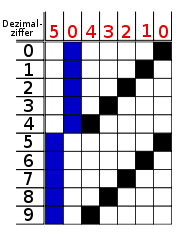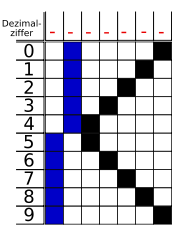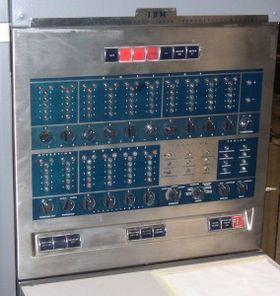
Bi-quinary coded decimal
Encyclopedia


Numeral system
A numeral system is a writing system for expressing numbers, that is a mathematical notation for representing numbers of a given set, using graphemes or symbols in a consistent manner....
used in many abacus
Abacus
The abacus, also called a counting frame, is a calculating tool used primarily in parts of Asia for performing arithmetic processes. Today, abaci are often constructed as a bamboo frame with beads sliding on wires, but originally they were beans or stones moved in grooves in sand or on tablets of...
es and in some early computers, including the Colossus
Colossus computer
Not to be confused with the fictional computer of the same name in the movie Colossus: The Forbin Project.Colossus was the world's first electronic, digital, programmable computer. Colossus and its successors were used by British codebreakers to help read encrypted German messages during World War II...
. The term bi-quinary indicates that the code comprises both a two-state (bi) and a five-state (quinary) component. The encoding resembles that used by many abaci, with four beads indicating either 0..4 or 5..9 and another bead indicating which of those ranges.
Several human languages, most notably Khmer
Khmer numerals
Khmer numerals are characters used for writing numbers for several languages in Cambodia, most notably Cambodia's official language, Khmer. They date back to at least the oldest known epigraphical inscription of the Khmer numerals in 604 AD, found on a stele in Prasat Bayang, Cambodia, located not...
and Wolof
Wolof language
Wolof is a language spoken in Senegal, The Gambia, and Mauritania, and is the native language of the Wolof people. Like the neighbouring languages Serer and Fula, it belongs to the Atlantic branch of the Niger–Congo language family...
, also use biquinary systems. For example, the Khmer word for 6, pram muoy, literally means five [plus] one.
Decoding
To decode the Biquinary code use the number 5043210.At each digit multiply the biquinary number by the number 5043210. This will give you one decimal digit.
For example take the number 0110000. To change this into decimal:
-
- (5 × 0) + (0 × 1) + (4 × 1) + (3 × 0) + (2 × 0) + (1 × 0) + (0 × 0) = 4
Examples
Several different representations of bi-quinary coded decimal have been used by different machines. The two-state component is encoded as one or two bitBit
A bit is the basic unit of information in computing and telecommunications; it is the amount of information stored by a digital device or other physical system that exists in one of two possible distinct states...
s, and the five-state component is encoded using three to five bits. Some examples are:
- IBM 650IBM 650The IBM 650 was one of IBM’s early computers, and the world’s first mass-produced computer. It was announced in 1953, and over 2000 systems were produced between the first shipment in 1954 and its final manufacture in 1962...
– 7 bits (two ‘bi’ bits: 0 5 and five ‘quinary’ bits: 0 1 2 3 4) with error checking (exactly one ‘bi’ bit and one ‘quinary’ bit set in a valid digit); in the picture of the front panel below, the bi-quinary encoding of the internal workings of the machine are evident in the arrangement of the lights – the 'bi' bits form the top of a T for each digit, and the 'quinary' bits form the vertical stem (the machine was running when the photograph was taken and the active bits are just discernible)
| Value | 05-01234 Bits |  |
| 0 | 10-10000 | |
| 1 | 10-01000 | |
| 2 | 10-00100 | |
| 3 | 10-00010 | |
| 4 | 10-00001 | |
| 5 | 01-10000 | |
| 6 | 01-01000 | |
| 7 | 01-00100 | |
| 8 | 01-00010 | |
| 9 | 01-00001 |
- UNIVAC 60 and UNIVAC 120 – 5 bits (four ‘quinary’ bits: 1 3 5 7 and one ‘bi’ bit: 9)
| Value | 13579 bits |
| 0 | 00000 |
| 1 | 10000 |
| 2 | 10001 |
| 3 | 01000 |
| 4 | 01001 |
| 5 | 00100 |
| 6 | 00101 |
| 7 | 00010 |
| 8 | 00011 |
| 9 | 00001 |
- UNIVAC Solid StateUNIVAC Solid StateThe UNIVAC Solid State was a 2-address, bi-quinary coded decimal computer, with memory on a rotating drum with 5000 signed 10 digit words, spinning at 17,667 RPM in a helium atmosphere. It was announced by Sperry Rand in December 1958, as a response to the IBM 650...
– 4 bits (one ‘bi’ bit: 5 and three binary coded ‘quinary’ bits: 4 2 1) with 1 parity check bitParity bitA parity bit is a bit that is added to ensure that the number of bits with the value one in a set of bits is even or odd. Parity bits are used as the simplest form of error detecting code....
| Value | p-5-421 bits |
| 0 | 1-0-000 |
| 1 | 0-0-001 |
| 2 | 0-0-010 |
| 3 | 1-0-011 |
| 4 | 0-0-100 |
| 5 | 0-1-000 |
| 6 | 1-1-001 |
| 7 | 1-1-010 |
| 8 | 0-1-011 |
| 9 | 1-1-100 |
- Univac LARC – 4 bits (one ‘bi’ bit: 5 and three ring counterRing counterA ring counter is a type of counter composed of a circular shift register. The output of the last shift register is fed to the input of the first register.There are two types of ring counters:...
coded ‘quinary’ bits) with 1 parity check bit
| Value | p-5-qqq bits |
| 0 | 1-0-000 |
| 1 | 0-0-001 |
| 2 | 1-0-011 |
| 3 | 0-0-111 |
| 4 | 1-0-110 |
| 5 | 0-1-000 |
| 6 | 1-1-001 |
| 7 | 0-1-011 |
| 8 | 1-1-111 |
| 9 | 0-1-110 |
See also
- chisanbop
- BinaryBinary numeral systemThe binary numeral system, or base-2 number system, represents numeric values using two symbols, 0 and 1. More specifically, the usual base-2 system is a positional notation with a radix of 2...
- Binary-coded decimalBinary-coded decimalIn computing and electronic systems, binary-coded decimal is a digital encoding method for numbers using decimal notation, with each decimal digit represented by its own binary sequence. In BCD, a numeral is usually represented by four bits which, in general, represent the decimal range 0 through 9...

